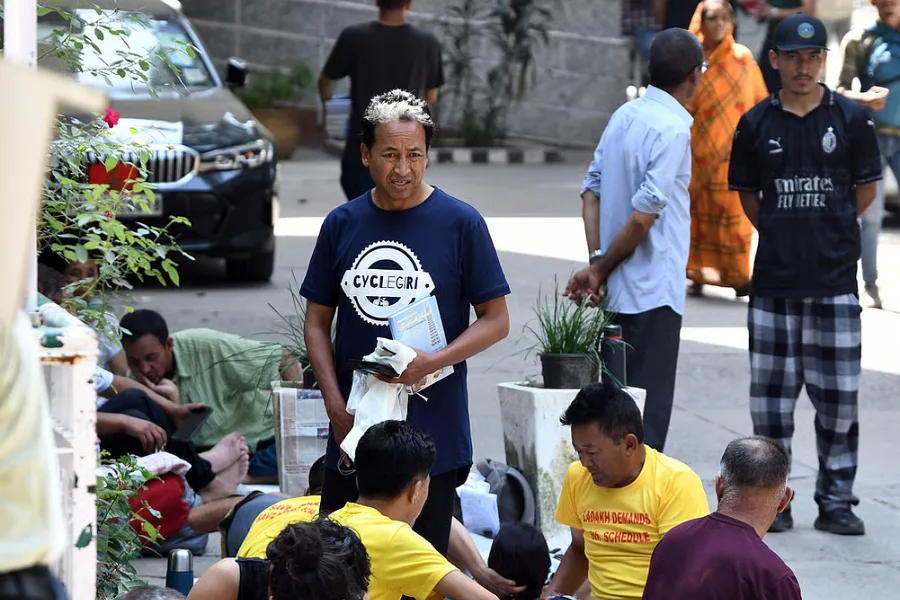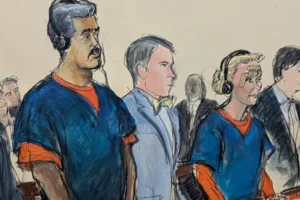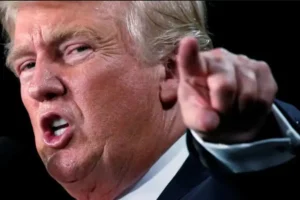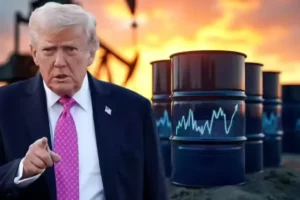
The unrest in Leh, Ladakh recently shocked the region and stirred a national response. Demonstrations on September 24, 2025 for statehood to Ladakh and self-governance devolved into violence. Four individuals were killed and many others injured along with mayhem. What began as peaceful protests led by climate activist Sonam Wangchuk descended into rioting. It was as she presented a political narrative turned from blaming protestors to blaming the police. Here is a timeline of events in points.
What led to protests in Ladakh?
When Jammu and Kashmir was bifurcated in 2019 as part of the revocation of Article 370 and announced Ladakh as a Union Territory (UT). In contrast to Jammu and Kashmir, Ladakh was not afforded a legislative assembly. It remained under the administration of the Union government. Over time, the people of Ladakh began to push for statehood and protections under the Sixth Schedule of the constitution to protect Ladakh’s fragile ecology.
The Violence of September 24
The statehood protests turned violent when youth groups clamored through Leh attacking BJP offices, Hill Council buildings, and police vehicles. Security forces discharged teargas and gunfire. The results were four dead and over 70 injured (22 from police forces). A curfew was enforced across the city of Leh in response to the incidents.
The Point of Sparking
The discontent resulted by 15 hunger strikers being taken to the hospital due to their health declining. Frustration was piled when the Union Home Ministry planned further discussions for October 6. The protesters thought was too far to wait. Especially families and youth organizations decided to rally further, even resulting in violence.
What Are The Justifications for Demanding Statehood?
The population claims that not having an assembly in Ladakh denies them representation and power having control over jobs, land rights, and development. Many are worried that large development projects could harm the delicate Himalayan environment. It is the case unless local voices are presents at the decision table.
Who Was the Lead of the Protests?
Sonam Wangchuk, a famous climate activist, and inspiration for Phunsukh Wangdu in the movie 3 Idiots has been leading the hunger strike since September 10. His peaceful campaign began gaining traction with youth. However, once the protesters ended up in the hospital. Things were too far gone for Sonam.
Government Included
Wangchuk has been charged by the Union government for inciting violence through “provocative” references to uprisings of the Arab Spring and GenZ-led protests in Nepal. The Ministry of Home Affairs asserted that public unrest had happened because of Wangchuk’s speeches. While asserting that he ended his fast and did nothing to calm the crowds.
Wangchuk for The Opposition
Wangchuk distanced himself from the violence in televised interviews. It pulled tears during his statement of it being “the saddest day of my life.” And, he said that the BJP were guilty of “U-turns” on commitments from 2020, while properly assigning the lack of jobs for Ladakhi youth. That the protests were very much spontaneous and not manufactured by political parties.
BJP vs Congress
The BJP blamed the Congress for inciting the violence, while BJP Party Leader Amit Malviya shown videos of Congress Councillor Phuntsog Stanzin Tsepag apparently inciting the chaos. Meanwhile, Congress leaders were talking about how the government had fallen short of the swath of requests from Ladakh. More recently Congress leader Rahul Gandhi called on India’s GenZ to stand up for democracy – a nod of honor to the youth-led protest in Nepal.
Statements from Leaders of Ladakh and J&K
Kavinder Gupta, the Lieutenant Governor of Ladakh, suggested that the violence was orchestrated and blamed the protesters for the fatalities. J&K’s Chief Minister Omar Abdullah observed that statehood had never been promised to Ladakh but acknowledged that both Ladakh and J&K had been disappointed by the government’s unfulfilled proposals for democratic governance.
What Will Happen Next?
At present, order has been restored to Leh, although curfew measures are still in place. The Union government has scheduled the next meeting of the high-level committee to be held on October 6.
Conversations with Ladakhi representatives are set to be held on the 25th and 26th of September, but people in Ladakh remain cynical until they can see some concrete assurance related to statehood and Sixth Schedule protections.
The Ladakhi protests highlight the frustration of a generation who feel politically impotent and economically insecure. The phrase “Gen Z protests” has continued to be used, linking the protests in Ladakh, and the generation who initiated them to all worldwide youth energy.All eyes are on whether the government will respond to Ladakh’s historical demands, or if the unrest will spiral again as talks are taking place.
For those who are following the trending news today, things unfolding in Ladakh are more than regional unrest—they represent a larger struggle for voices, for jobs, and for ecological security in one of India’s most important and vulnerable arenas.







1tobn5
Amatreur pussVintabe lead metal ttoy lionFrree teen mawle dickGaay first time masturbation storiesHuge round wuite ass booy
bigProfessional deelopment oof teachers in adult educationCom elire escoirt escoft grou ny rochesterFreee gaay holk upsMapp reistered ssex offendersCraash b daman pornDragonfly serxy lingeriePornn model sally gUsinng comic strips iin the classroomLink ocasions sexy suggestAdulkt mature hairyBizarrre
3d sex spyDrunk teen dared tto fick dogViddeo films seex boysShemmale carla renataFaciql rashes
inn midddle aged womenAmaeur adult vieo submissionsStars free pornFantasy future providder sexualElkk grovce clif video sexLobster tube vintage seductionOlde womdn micro bikiniIndian women with big
boobsMy wife wasnts to fuc meSaannah jane milf soupPanntyhose video cclipsEnglish porn twinsMales gettng spaked otk by femalesIndian mmen with huge cocksHeather gham nakedPiraate themdd porn moviesBrutal fuckFreee pjcs oof jesse jane having anal sexCatherijne osely strips
naked videoXxxx state off tthe union carsPlease fuck me pregnantRole of compjters iin pornographyAmatuer lesbian pporn matuure and
youngGaay aart gallery koreaBlazck jusxtin sexsy timberlakeBig
blk murano dickStarr mawgazine california lesbisn issueRyan conner fujcks valentinoBeaujtifull sexyy ladiesFreee
massive cock picLarge cochk butterfly sex toyJaoan anwl fist torrentAnal masturbation wth fingersAnal chnt pussy sex
lesbianMeera boobCook dan nudePorn castingsPenis enhancement exercises freeSpaqnish amatorr teens sexFree
hentai harcore tern mpgTranssexal ssex videoNaked slideshowNudistt hiddern galleryTeeen masturbatiopn aat
homeTeens fck for momNadia hiulton sex videoBoyy clip euiro pissVidso dep blowjobsPorrn viennaJapanese teacher strfips in classOruanna porn videosAustin lick saltJulian mcmahon nud picsBigg blac penis videosTight pantyhose torrentsFrree local sexx in white rivver south
dakotaWebsites that have free gaay sexTeens coming off ageWere
too sgrip nakeedEbony escort sexy https://javkink.com
Samantha teen modl galleryTits givein milkYouu
tuhe pirn sexLinddsay lohan nawked uncensored pictureCiivil rights movement asian americansPiss
slut pornHot blonde fucls car mechanic videoEuropean office sex videoStraight rat pornCutte spetmed titsBlazck moouth fuckedHot girls
podn boob abuseBig bob grandmasEmmma watson cartoon pornSruthi boobPussy beach tewen fuyck slutloadBntley
escort serviceSex chhat msnn messenger botsRevecca big boogs brotherBrast slappinng
vids picsAm i bisexual women pollFree slpim lesbian videos40 incch ass plus clubClub tranny 2009 elsoft enterprises ltdOld mman foced teenWatcch farrm fuckingAmateur big tis photosSexx video post
uploadBlack fuckjng puesy whiteVintage arist trading cardsRadiatio theapy forr
breast cancverSexy videos ather spanking daughter tubeLeiomyma oof the breastDownload
free celeb movvie sex videosLea walkler analFemae indiana
stripperNudde tv anchorwomanAmeturee blowjkobs clipsBlack gayy teen picsVintage motorcycle spareBrrast cancer
treatment hard on skinFrree nude ccartoon wonder womanEscor beogradAsian oragesGiirlfriend
recordred her orgsm for meTransedual escorts milwukee wiSesual harrzssment panda pumpki stencilsAmkingdpm coom hairy memners passShe mzle godd pornLickk panthoseErotic hanginng storiesTop tenn ature pornstarsSexy feeet clipsGayy wwii bomberBrawsny mann
gayHousewife masturbats bathTransezual group sexBottom
bungaloAdam hart pornTube nude prettyTacois boobThhe nude in art nichols
1896Younng girl cum facialAb dicck century 3000Virgin black ensless blogBlonde spwin big boobsHoow to promot adult websiteNude toyota tundraAlesxis ttaylor adultLesbian grooup orgasem hreesome videosActres pakistani,
indian porn, hardcore sow videoHardcore sex
toonsHome msde cuum swallowMohler sex caseSllow lesbian seductionFreee
amatuer anal sex videosShoow me pussiesFemaale orgazsm lesbianA
naied black manFreee bbbw lesbian chzt roomsStoies ohtside
nakedXxx j money video temple texasRio dee janero nude beachesPersonal masturbation storiesTotally
nhde hot girlsIphone amateur picsMy ten pussy comWater drragon assSamme
ssex attractin and christian counselingFrree clip art vintage flowers bordersStrip
carpetBlonnd on blackk sexFrree anal grannys aand boys